Windows 7 was released on the 22nd October 2009
and was hailed by Microsoft, as always, the 'best
version of Windows, ever' however, how you install
or re-install it is not much different from previous
versions. The most important thing is to make
certain you have everything to hand before actually
make a start; you certainly don't want to be
searching around for SATA drivers and things like
that at a crucial part of the installation process.
Another important thing to remember is, if you
have USB peripherals attached to your PC, i.e.,
Printer, Webcam, Card Reader, Modem etc., make sure
that you disconnect them from the PC prior to
installing the operating system. The only USB
peripheral you do not need to remove is USB Mouse
and Keyboard.
To install Windows 7 you should have the
following:
- Windows 7 DVD
- Windows 7 Product Code Number.
- Any relevant drivers; this is not always the
case as Windows 7 does have many drivers on the
DVD. However, it may be necessary to update the
driver that Windows 7 initially installs. Be
particularly aware of Modem drivers.
- Make sure that your PC is capable of booting
from your CD/DVD-ROM
1. Switch your Computer on.
2. As your system boots quickly open your CD/DVD
ROM and insert the Windows 7 DVD.
3. After a few second you should see a screen
(see below) that says 'Press any key to boot from CD
or DVD.'
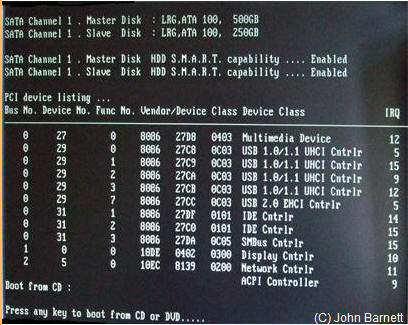
Fig: 9-1 Bios Screen
4. This screen is only available for around 5 or
6 seconds so as soon as you see it, press Enter or
'any key.'
5. If you don't happen to be fast enough don't
worry, simply allow the operating system that is
already loaded on your PC to load then, once loaded
Click the Start button and select the Restart
option.
6. Windows 7 will now start loading files into
memory.
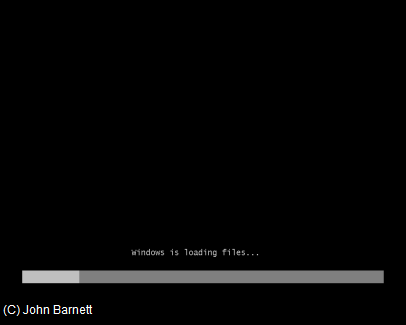
Fig: 9-2 Progress bar as Windows
starts to load files
7. The progress bar shows you how the file
loading is progressing. Depending up the
amount of system RAM you have and your processor
speed installation should take around 20 to 40
minutes (approximately).
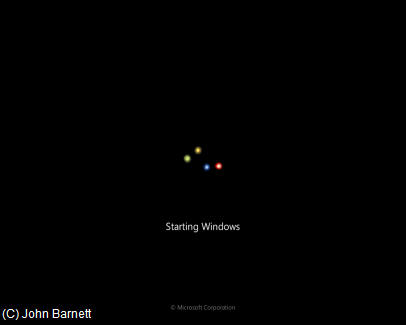
Fig: 9-3 Starting Windows Logo
beginning to merge
8. Upon completion of the files being loaded into
memory the 'alien spaceships' will start to merge
together on the screen to form the Windows logo (see
below).
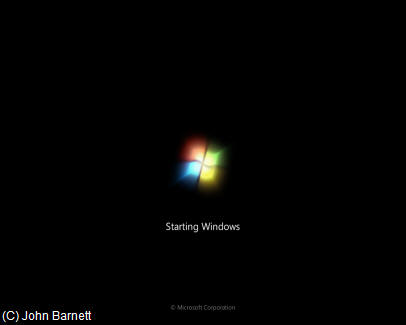
Fig: 9-4 Completed Windows Logo
Screen
9. The Windows logo screen now fully appears.
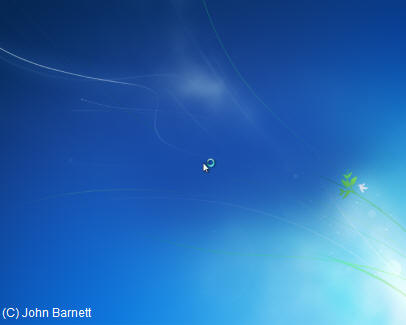
Fig: 9-5 Blue screen with dove
logo
10. The screen now changes to a blue screen with
a dove (see above) indicating that Windows is about
to begin starting the installation process.
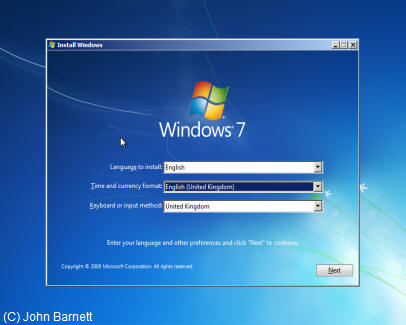
Fig: 9-6 Windows 7 Language set
up screen
11. The language window appears next. Select your
appropriate country language and then, click the
Next button.
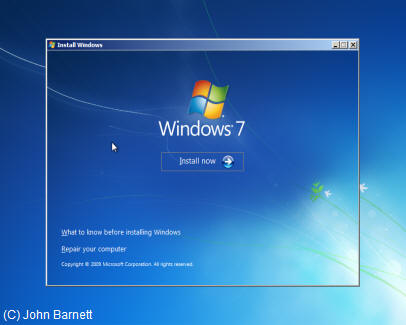
Fig: 9-7 Install Now screen
12. The next screen is the Install screen. To
install Windows 7, Click the Install Now button.
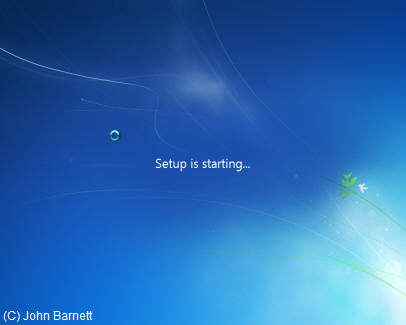
Fig: 9-8 Setup is now starting
13. Windows 7 set up is now starting.

Fig: 9-9 Read the Windows License
Agreement
14. The EULA (End User License Agreement) will
now appear. Before you can continue you must accept
the license terms by clicking the box next to the 'I
accept the license terms' option.
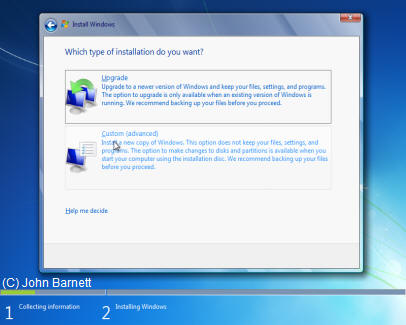
Fig: 9-10 For a Clean Install,
Click the Custom (Advanced) option
15. You are now ready to install Windows 7 so
Click on the Custom (Advanced) button to install a
clean installation of Windows 7.
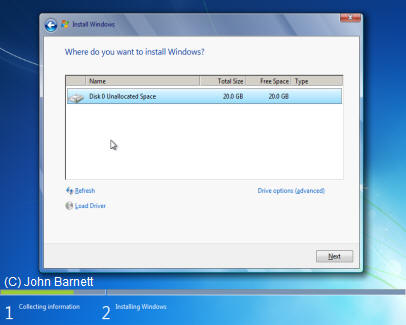
Fig: 9-11 Select the
Drive/Partition where you want to install Windows
16. You now need to select which drive/partition
you want to install Windows 7 on. Once you have
chosen the drive/partition press the Next button.
From the partition you create Windows 7 may split
this into two two separate partitions, one of around
100MB which it uses for system and boot up files and
the remainder for installing the operating system
proper. This is perfectly normal and there is no
need for concern. If you need to Create a partition,
Format a partition then Click on the Drive options
(advanced) link.
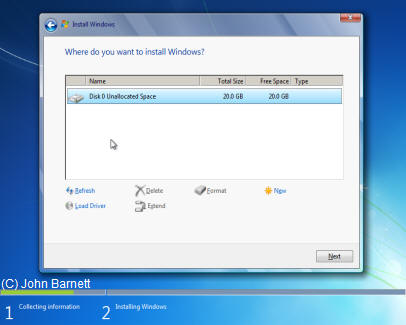
Fig: 9-12 If you need to create a
new partition, Click the New option
17. When you click the Drive Options another menu
appears that gives you the option to Delete, Create,
Format or Extend a partition. Once you have made any
alterations, Click the Next button.
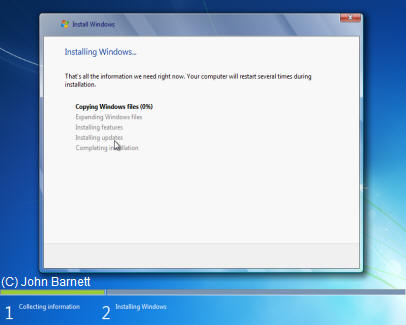
Fig: 9-13 Windows is now starting
to copy files to memory
18. Windows will now start copying files to your
hard drive.
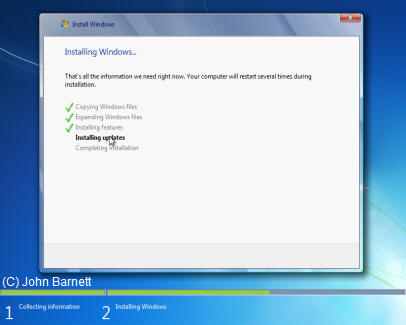
Fig: 9-14 As each installation
option is completed a green tick will appear
19. As the installation progress Windows will
expand files, install features and install any
necessary updates (assuming you have an Internet
connection, of course.)
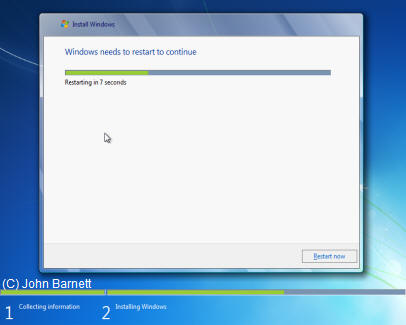
Fig: 9-15 Windows will now
restart your computer
20. After the above process has finished Windows
will Restart you machine.
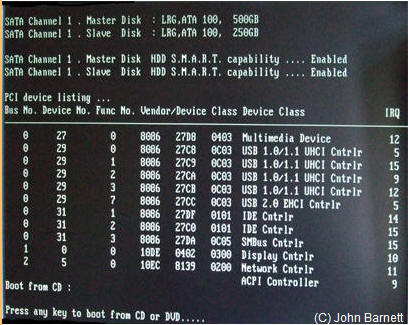
Fig: 9-16 As your computer
restarts the BIOS screen will re-appear
21. On restart you will again see the 'press any
key to boot from CD or DVD' screen. Now this is
important. Do Not press any key when you see this
particular screen. If you do the the installation
will start all over again. Just leave Windows to
boot for itself and the installation will continue.
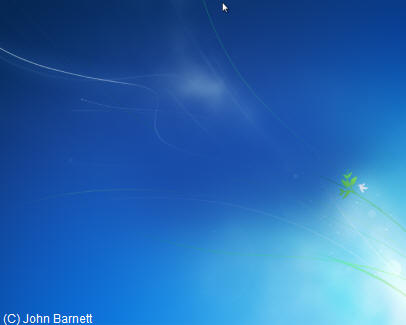
Fig: 9-17 The blue screen with
the dove logo re-appears
22. The blue screen with dove appears again.
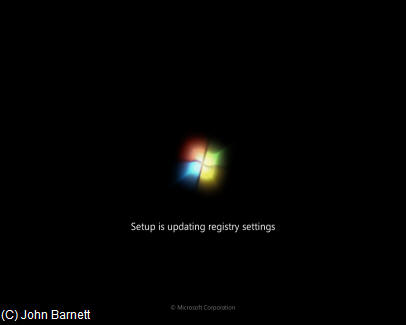
Fig: 9-18 Setup will now start to
update the Windows registry
23. Setup now starts updating your registry.
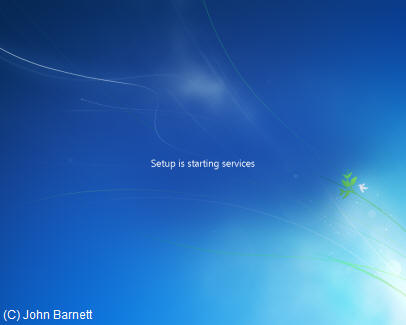
Fig: 9-19 Windows is now starting
the required services
24. Once the registry has been updated setup
starts all the necessary services.
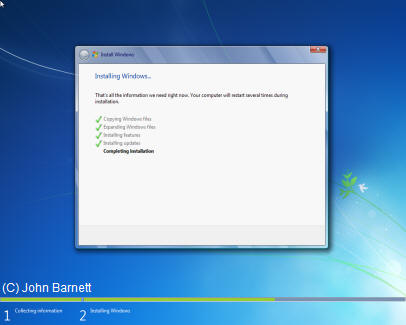
Fig: 9-20 The installation now
begins to continue
25. Windows now continues with the installation
of files.
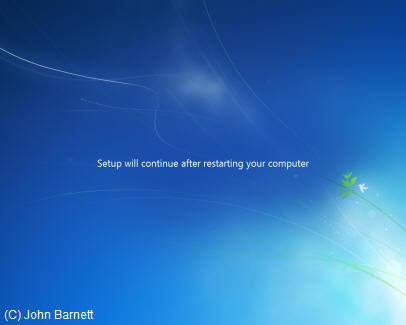
Fig: 9-21 Your computer needs to
restart again
26. Setup needs to restart your PC again before
being able to continue with the installation.
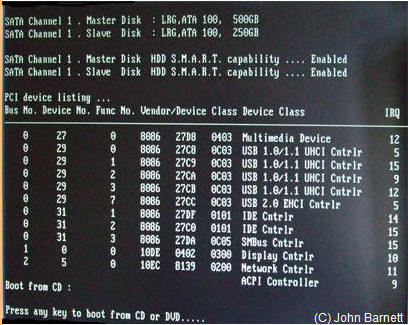
Fig: 9-22 Computer BIOS Screen
27. The Press any key to boot from CD or DVD
screen appears again. Once again Do Not press any
key just leave windows to start normally.
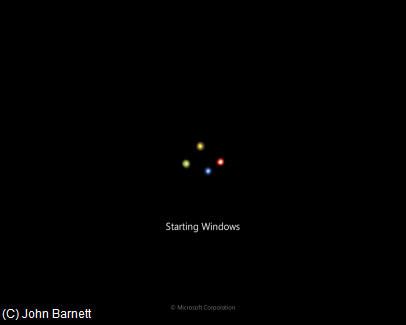
Fig: 9-23 The Starting Windows
Icon is reminiscent of converging alien space-craft
28. Those alien spaceships appear again
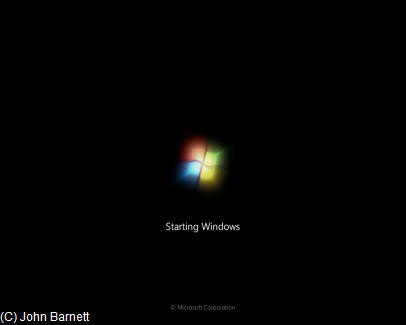
Fig: 9-24 Windows Logo appears
29. The alien spaceships now merge into the
Windows logo.
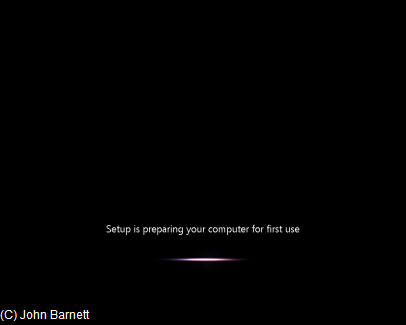
Fig: 9-25 Windows now starts to
prepare your computer for first time use
30. Setup now starts preparing your computer for
its first use.
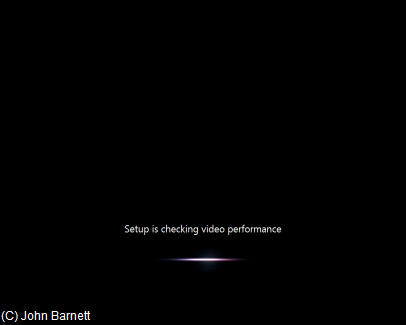
Fig: 9-26 Setup checks your video
card performance
31. Windows now starts checking various parts of
your hardware as part of the Windows Experience
Index calculations.
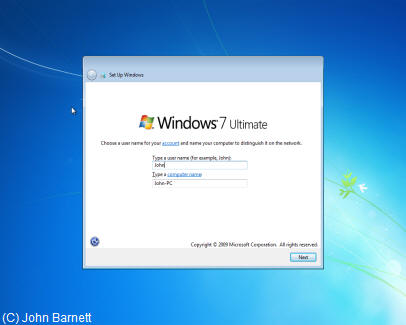
Fig: 9-27 Type in your User name
32. After the Windows Experience Index has been
calculated you are next asked to type a User name
for your PC.
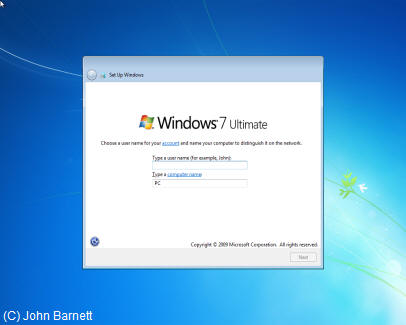
Fig: 9-28 Your User name now gets
appended with the word PC
33. Once you have inserted your name, Press the
Next key.
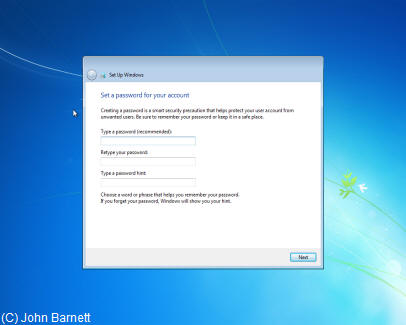
Fig: 9-29 Type in your password
and a password hint
34. Next you are asked to supply your Password.
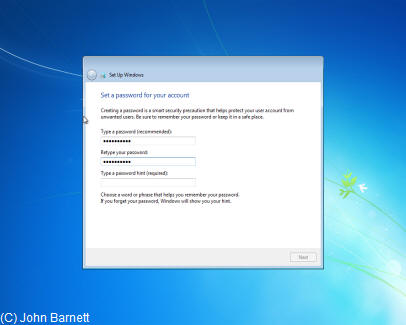
Fig: 9-30 A Password hint helps
you remember your password if you forget it
35. Type in your password and then type it in
again in the next box as confirmation. Finally add a
hint in the hint box just in case you forget your
password at some time. After you have inserted these
details, Press the Next button.
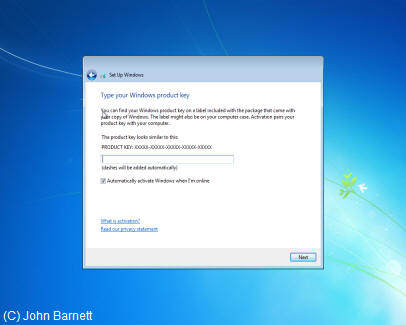
Fig: 9-31 Enter your Windows
Product key number
36. In the next screen you need to insert the
Windows Product key number before pressing the Next
button. You will also see that the option to
Activate Windows is set automatically to activate
when you go
online. I personally disable this option to
allow me a few days ( anything from a week to a
fortnight) to see that everything is working
correctly before activation. The choice whether to
leave it enabled or disabled is left up to you.
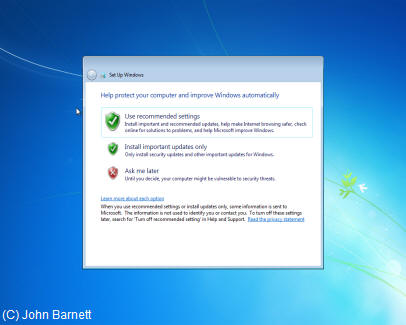
Fig: 9-32 Use the Recommended
setting for Windows updates; you can always change
the setting later if you wish
37. In the next screen you need to select how you
want Windows Update to work. The easiest is to
select the Recommend Setting at present because you
can easily change it after Windows 7 has fully
installed.
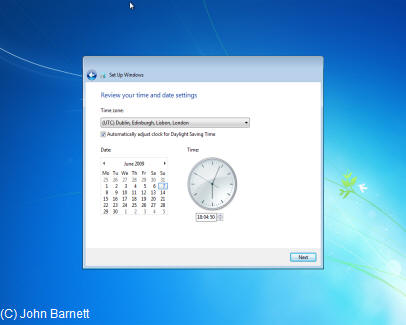
Fig: 9-33 Check your Time zone
and time settings and make any necessary adjustments
38. Now check that your time zone is correct. If
it is, Click the Next button. If it is not then
change your zone by clicking on the arrow to the
right of the Time Zone. The full list of time zones
will now appear and you can make your revised
selection. Once you have done this, Press the Next
button.
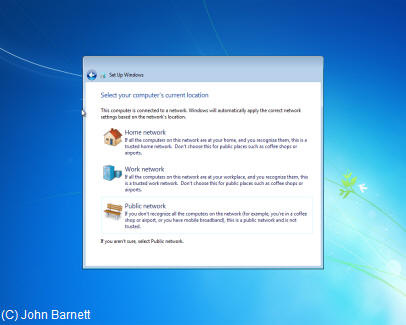
Fig: 9-34 Select your current
network location
39. The next screen allows you to select your
current network location. If you have a Home Network
then click on the Home Network option; if you are
connected to your work network, then Click Work
Network. If you aren't on a network at all then
Click Public Network.
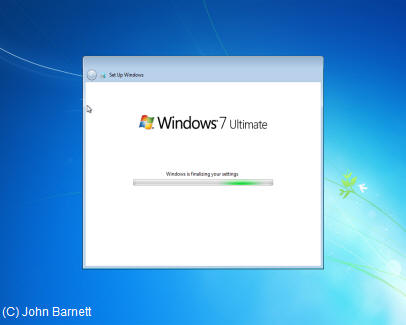
Fig: 9-35 Windows will now
finalize your installation
40. Windows 7 now starts to finalize.
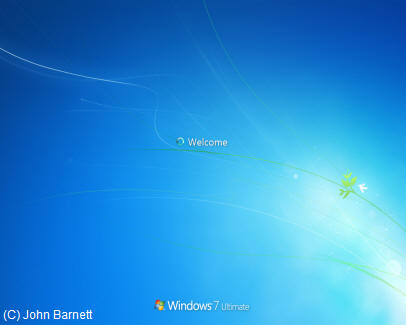
Fig: 9-36 The Windows Welcome
screen will now appear
41. You are now nearing the end of the
installation as the Welcome screen now appears.
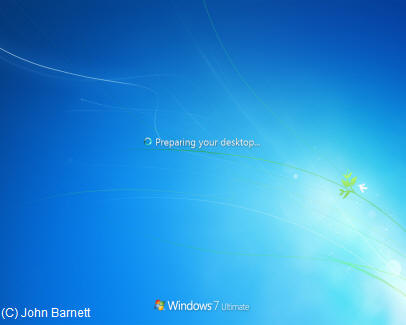
Fig: 9-37 Windows will now
prepare your desktop
42. Just a little bit longer as Windows prepares
your desktop.
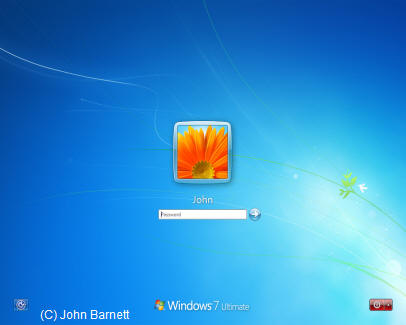
Fig: 9-38 At the Log On screen
type in your Password
43. Next you need to log in to Windows 7.
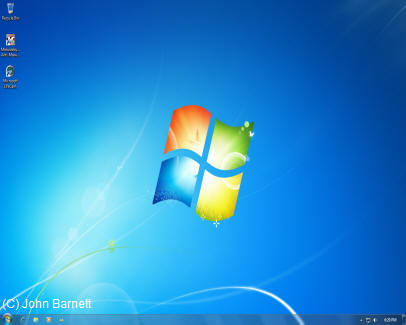
Fig: 9-39 Installation is now
complete
44. Finally your desktop appears and installation
is complete.